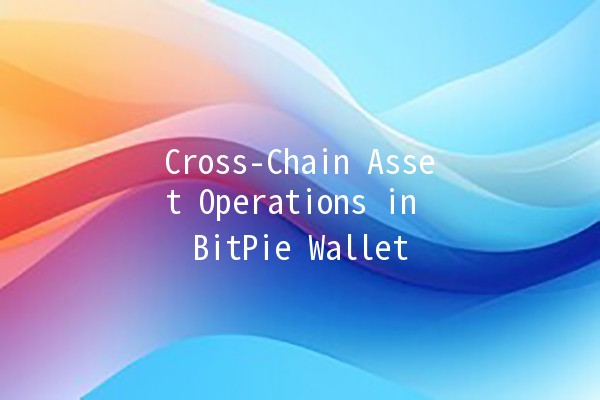
Transacting with cryptocurrencies has become increasingly popular, yet many users still find it challenging to navigate the various wallets and exchanges available. One common frustration is the need to shift assets between different blockchains. In this article, we will explore crosschain operations within the BitPie wallet, providing practical tips and techniques to enhance your productivity.
BitPie wallet is known for its userfriendly interface and robust performance in managing multiple cryptocurrencies. It inherently supports crosschain operations, allowing users to interact with various blockchain networks efficiently. Our goal is to help you understand how to leverage this functionality, ultimately improving your digital asset management experience.
Understanding CrossChain Operations
Crosschain operations refer to the ability to transfer assets between different blockchain networks. This is crucial, especially as more cryptocurrencies emerge, each with its set of characteristics and use cases. The necessity for seamless interactions among these networks has led to the development of various protocols and tools that facilitate crosschain transactions.

Why CrossChain Operations Matter
Getting Started with BitPie Wallet
To execute crosschain transactions in BitPie wallet, you need to familiarize yourself with the setup process and the inherent features.
Installation: Download the BitPie Wallet app from the official website or relevant app store. Ensure you are using the official source to avoid any security issues.
Creating an Account: Open the application, and follow the instructions to create your new wallet. Make sure to note your mnemonic phrase securely; it's your key to accessing your assets.
Adding Assets: Once your wallet is set up, you can add various cryptocurrency assets that you intend to use for crosschain operations.
The BitPie wallet is designed with simplicity in mind. Familiarize yourself with the dashboard, where you'll find the following functions:
Asset Overview: View all your holdings in a single glance.
Transaction History: Keep track of your past operations, which is crucial for monitoring crosschain activities.
Exchange Feature: BitPie wallet includes a builtin exchange, which facilitates easy swapping between cryptocurrencies.
Five Productivity Tips for CrossChain Operations
Example: Suppose you wish to move Ethereum (ETH) to a decentralized finance (DeFi) platform on Binance Smart Chain. Research current ETH price trends and Binance Smart Chain gas fees before proceeding.
Example: You could pair BitPie with a wallet like Trust Wallet, which supports more tokens and options, giving you greater flexibility in your trading strategies.
Example: Use BitPie’s alert system to get notified when the price of a specific token dips below a certain level. This ensures you can act quickly to capitalize on buying opportunities.
Example: If transferring assets from Ethereum to Polygon, note that Ethereum gas fees can be substantially higher than fees for Polygon. Timing your transactions to avoid peak periods can save you money.
Example: Schedule a monthly review of your wallet's security settings to ensure you haven’t overlooked potential vulnerabilities.
Common Questions About CrossChain Operations in BitPie Wallet
BitPie Wallet stands out for its crosschain feature, enabling users to handle multiple cryptocurrencies seamlessly. This allows you not only to diversify your holdings but also to engage with different blockchain functionalities without the clutter of managing separate wallets for each chain.
To execute a crosschain transfer, select the asset you want to send, choose the target blockchain, and follow the prompts. Be certain to doublecheck the transaction details before confirming.
While there are no strict limits in terms of asset types, certain blockchains may impose restrictions on specific assets or transaction sizes. Always check the individual blockchain’s guidelines prior to initiating a transfer.
If your transfer doesn’t appear, first check the transaction status via the blockchain explorer relevant to the network you're using. If the transaction is confirmed, but the funds aren’t visible, restart the BitPie Wallet app and refresh your transaction history.
Keep your wallet software updated, use strong passwords, and never share your mnemonic phrase. Consider enabling twofactor authentication if supported by your wallet.
Yes, BitPie Wallet supports builtin swaps between certain cryptocurrencies across chains. Utilize this feature to keep your portfolio dynamic without the need for external exchanges.
Additional s into Asset Management
Crosschain operations aren't only limited to trading; they can serve several other strategic purposes. For instance, utilizing particular blockchains for their unique dApps or DeFi protocols can significantly optimize asset performance.
To illustrate, consider a scenario where you leverage the speed of Solana for trading highfrequency assets while simultaneously utilizing Ethereum for its extensive ecosystem, including lending and borrowing platforms like Aave.
With the continuous evolution of blockchain technologies and increasing interoperability among tokens, mastering crosschain operations will become an indispensable skill for cryptocurrency enthusiasts.
Stay informed, keep your wallets secured, and leverage the powerful features of BitPie to make the most of your digital assets. Whether you’re diversifying your portfolio, seeking better trading opportunities, or exploring the everexpanding landscape of DeFi, crosschain operations can enhance your experience and success in the cryptocurrency market.
By adhering to the tips and utilizing the features mentioned above, you can streamline your crosschain operations and enhance your overall productivity. Engaging deeply with the functionalities of BitPie wallet not only helps in optimizing transactions but also opens doors to new investment strategies, ultimately supporting your digital asset journey.

